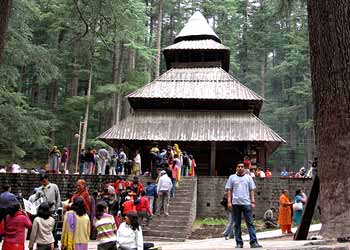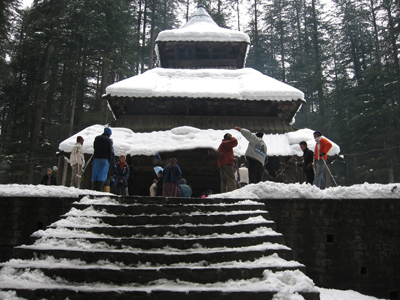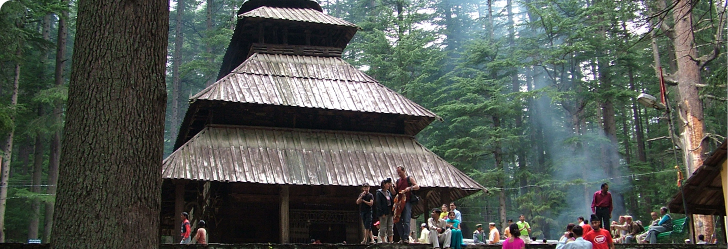Hadimba Temple Manali

A pagoda shaped roof, a front doorway covered with figures and symbols, intricate woodcarvings covering the pillars, doorposts and lintels and a deep pine forest near old Manali indicate that you have reached the temple of the 'Mother Goddess' of the valley. Dedicated to goddess Hadimba, the temple was built by Maharaja Bahadur Singh in 1550 AD.
A much revered deity of the locals, the Goddess is regularly consulted in times of natural hardship or calamity. Animal sacrifices are still made here in her honor. This four story wooden temple is located in the middle of a forest called the Dhungiri Van Vihar. Site of a major fair held at the valley, the temple of goddess Hadimba, a female demon of Mahabharata fame is also known as Dhungri Temple. It is customary fo the devotees to announce their arrival to the goddess by ringing the bells hung at the temple door.
History of Hadimba Temple - Himachal Pradesh
Legend states that the brother of the goddess, a demon named Hadimb used to rule some of the sub-mountainous tracts of the Himalayas. His sister, Hadimba fell in love with Bhima- one of the Pandavas who happened to step into the territory of Hadimb having escaped the wax house unhurt. On Hadimba's request, Bhima killed her brother and married her. Both of them lived in the valley for about a year after which Bhima joined his brothers and mother. During the course of time, Hadimba gave birth to a son who was named 'Ghatotkachh'.
Hadimba ruled the region till her son was grown up enough to look after his subjects. After which, she retired to the inner hills of Manali for meditation. Her resort for meditation came to be known as Dhungri and a temple was raised there to commemorate her supernatural powers. Since then, she became the patron-deity of Kullu kings. The throne taking ceremony of every king has to be necessarily done with the permission of the goddess.

It is customary to sacrifice a buffalo after worshiping her for a king. She is also a very important deity in the celebrations of the biggest celebration at the valley- Kullu Dussehra as the celebrations cannot begin before her arrival. The ceremonial horse of the festival is also blessed by the goddess from her temple only. This 500 years old temple is not enshrined with any idol. There just is a foot print in stone which is worshipped by the people. The people of the valley celebrate the birthday of their goddess on the first of 'Jaith' or 14th of May. Held in the Dhungri forest, this fair lasts for three days. Thousands of men, women and children partake in this grand fair and make themselves merry in music and dance.
Another indigenous ceremony at the temple observes a grand procession of Kartikswami of Simsa, Chhandal Rishi of Parsha, Shrishti Narayan of Aleo, Shriganh of Jagatsukh, Vishnu of Shajla, Maladevi of Sial and Sankh Narayan of Nasogi carried out by their followers at Dhungri. On the 4th day, the Jaith fair shifts to the Manu temple in the village Manali.
Hotels & Resorts
- Hotels in Shimla
- Hotels in Manali
- Hotels in Dharamshala
- Hotels in Dalhousie
- Hotels in Parwanoo
- Hotels in Shilon Bagh
- See More ...
Featured Tours
- Himachal Holidays
- Himachal Magic Tour
- Himachal Tour
- Complete Himachal Tour
- Himalaya Shimla Tour
- Himalaya Travel Packages
- See More ...



